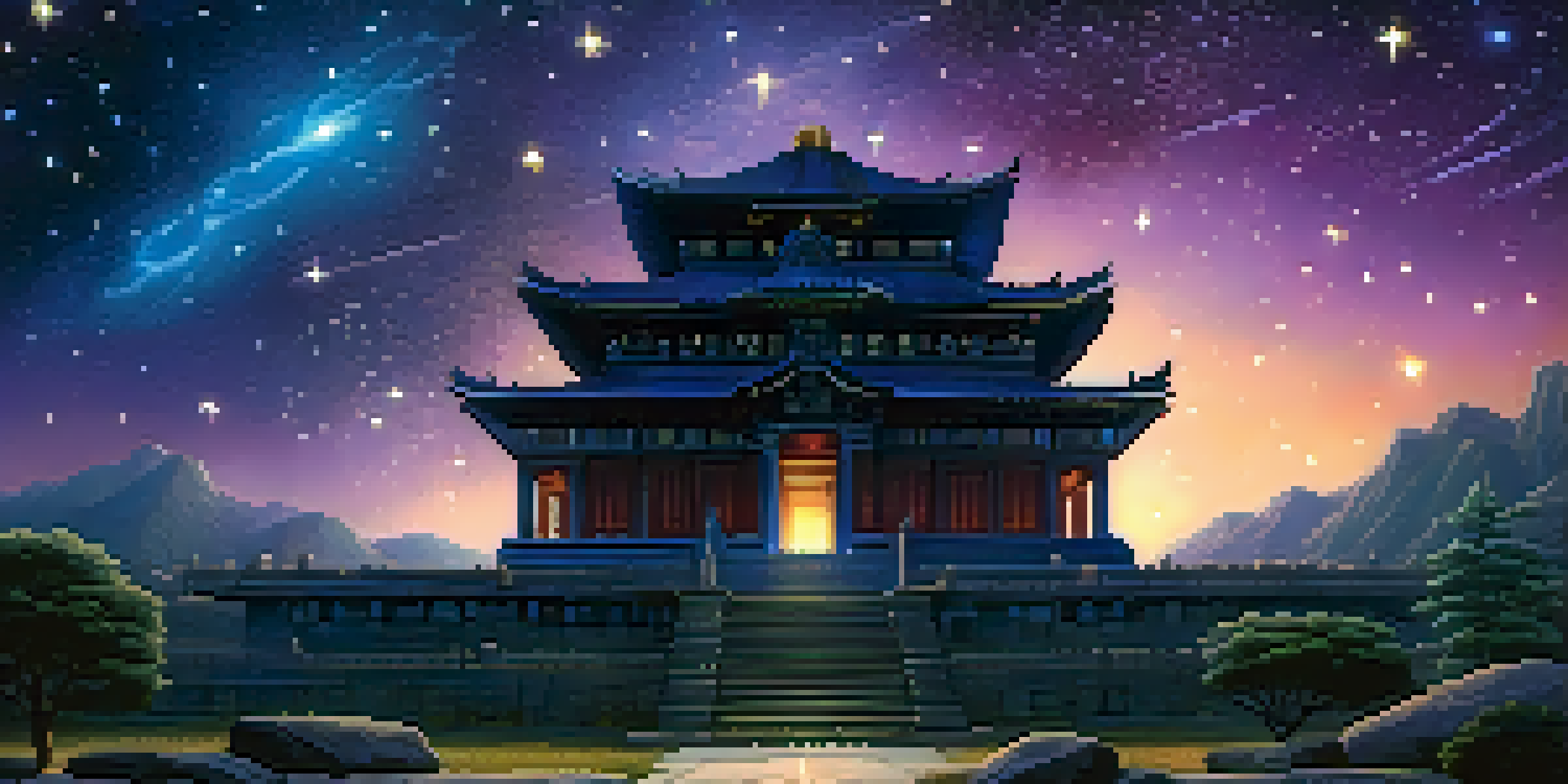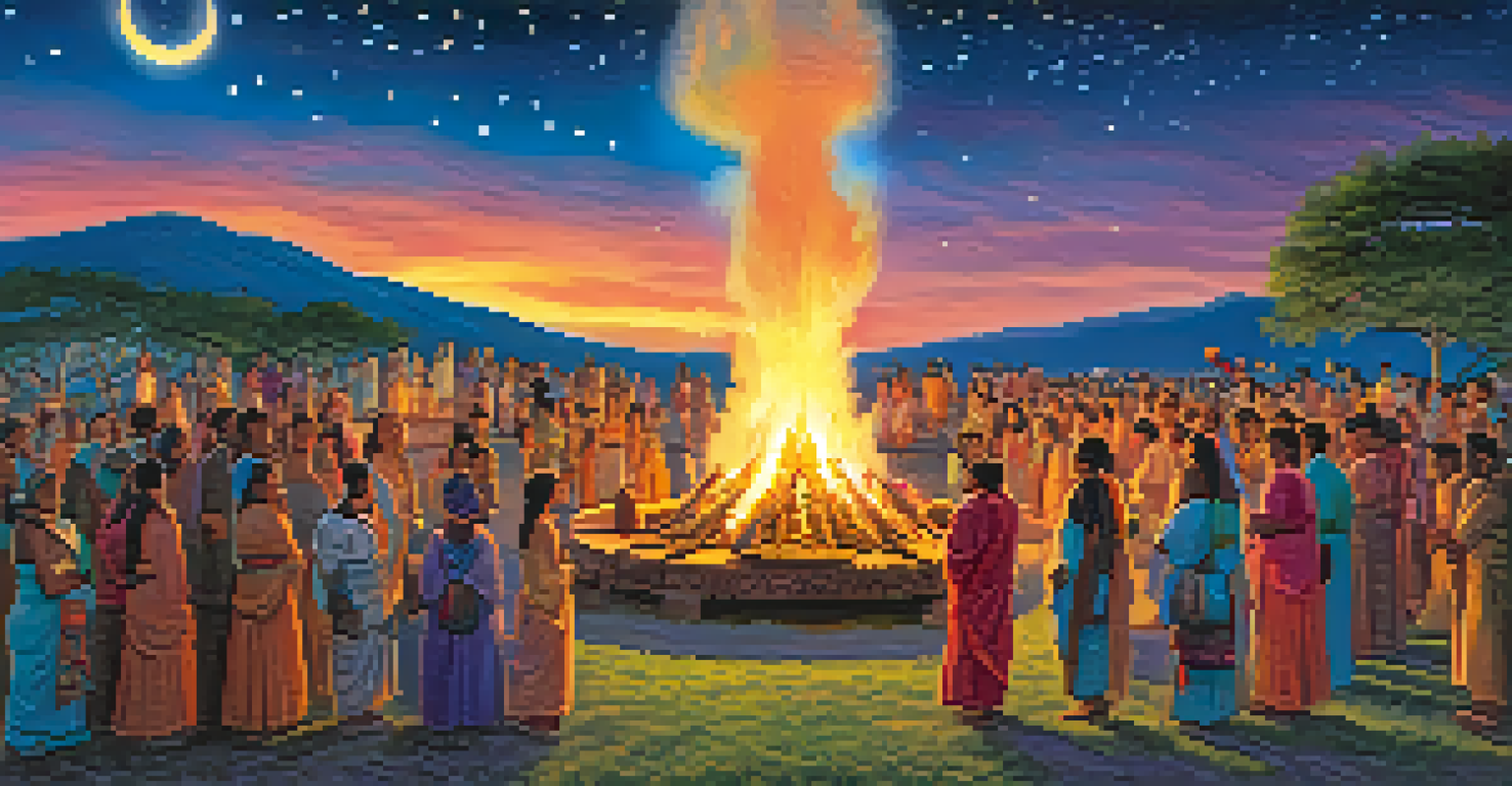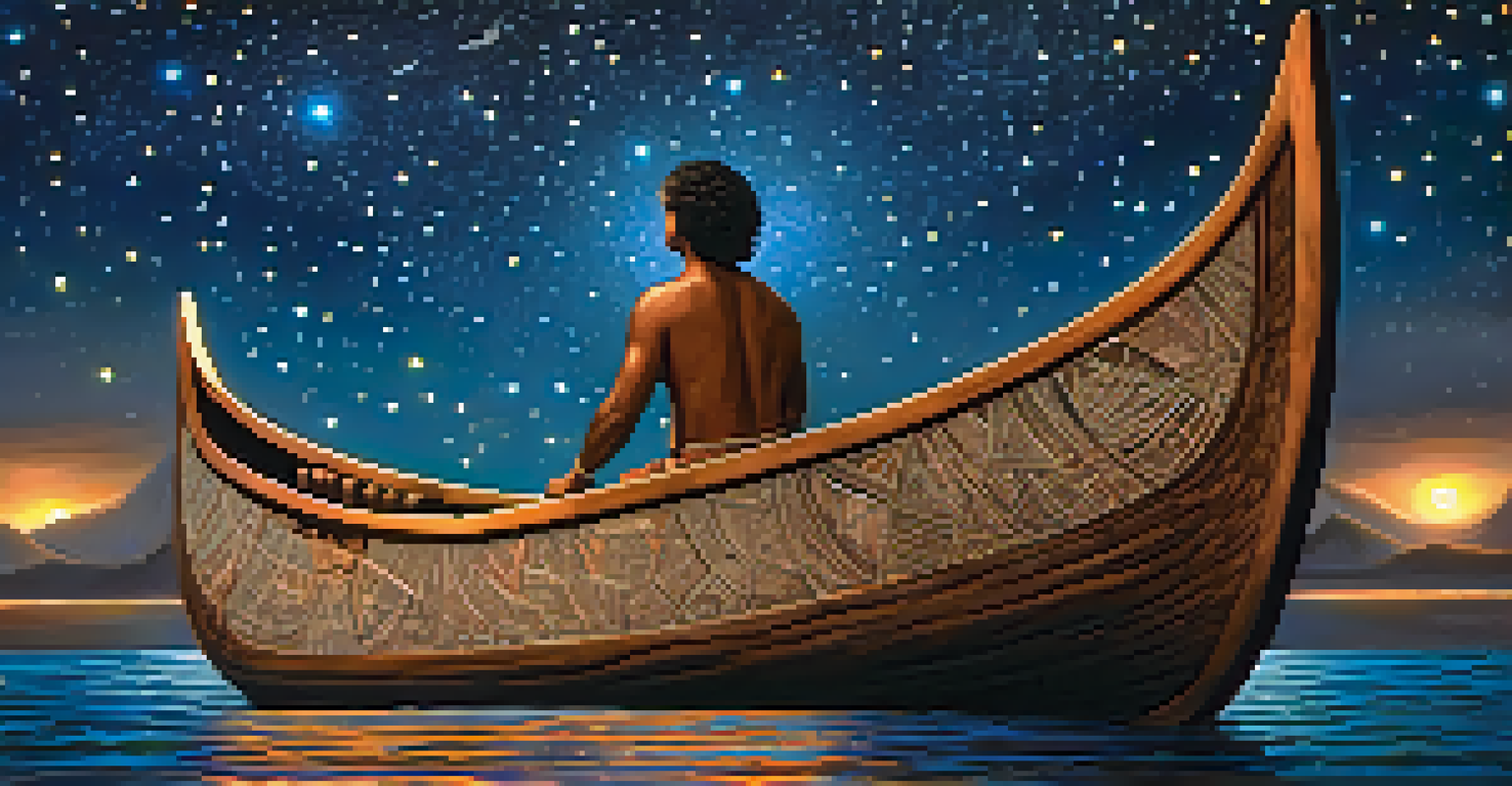The Influence of Stars on Ancient Spiritual Practices and Beliefs

The Night Sky as a Spiritual Canvas for Ancient Cultures
For ancient civilizations, the night sky was more than a backdrop; it was a canvas filled with stories and meanings. Stars served as waypoints in their spiritual journeys, guiding their thoughts and beliefs. Many cultures viewed celestial bodies as deities or messengers, intertwining their existence with the divine.
The stars seem to be telling us something about ourselves, reflecting our hopes, our fears, and our dreams.
Take the ancient Greeks, for instance, who attributed human-like qualities to constellations, forming myths around them. Similarly, the Egyptians saw the stars as a reflection of their gods, often aligning their temples and pyramids with celestial events. This connection fostered a deep reverence for the cosmos, influencing everything from architecture to daily rituals.
Thus, the influence of stars was not merely observational; it shaped entire belief systems. By interpreting the movements and positions of celestial bodies, societies crafted narratives that explained their existence and purpose, making the night sky a foundational element in their spiritual lives.
Astrology: The Celestial Influence on Personal Destiny
Astrology, the study of celestial bodies' positions and their alleged impact on human affairs, has roots in ancient practices. Early civilizations believed that the stars could predict personal outcomes, from love to fortune. This belief system was so integral that it permeated various aspects of life, including marriage and agriculture.

For instance, in Babylon, astrologers were highly respected figures, advising kings on governance based on celestial alignments. In India, Vedic astrology still shapes decisions from childbirth to business ventures, showcasing the enduring influence of these ancient practices. The stars weren't just distant objects; they were seen as active participants in human destiny.
Stars Shaped Ancient Belief Systems
Ancient cultures intertwined celestial observations with their spiritual beliefs, using the night sky to explain existence and purpose.
As astrology spread across cultures, it adapted but never lost its core belief in celestial influence. This connection between the stars and personal fate continues to resonate today, highlighting the timeless allure of looking to the heavens for guidance.
Rituals and Celebrations Aligned with Celestial Events
Many ancient societies structured their calendars around celestial events, such as solstices and equinoxes. These moments were not only astronomical occurrences but also spiritual milestones that called for rituals and celebrations. For example, the summer solstice marked a time of abundance, prompting festivals to honor the sun's return.
We are all in the gutter, but some of us are looking at the stars.
The Mayans and Aztecs, renowned for their astronomical observations, created elaborate ceremonies to align with celestial events. These rituals often included offerings, dances, and prayers aimed at appeasing the gods and ensuring a prosperous harvest. The alignment of human activities with the heavens fostered a profound sense of connection to the universe.
In this way, the stars dictated the rhythm of life for many ancient cultures. Through these celebrations, communities reaffirmed their beliefs, uniting in shared experiences that honored the celestial forces influencing their existence.
The Role of Stars in Navigation and Spiritual Journeys
Stars have long guided explorers and wanderers, serving as navigational tools that also held spiritual significance. Ancient mariners used constellations to chart their courses across vast oceans, often considering their journeys as quests for enlightenment. This dual role of stars as guides and spiritual symbols is a fascinating aspect of ancient belief systems.
For example, Polynesian navigators relied on their knowledge of the stars to travel thousands of miles across the Pacific Ocean. They believed that following these celestial pathways would lead them not only to new lands but also to spiritual growth. The stars became companions on their journeys, whispering secrets of the universe.
Astrology's Lasting Influence
Astrology, rooted in ancient practices, continues to resonate today by connecting celestial events to personal destinies.
Thus, navigation and spirituality were intertwined, with the night sky illuminating both physical paths and personal transformations. This relationship illustrates how the stars served as bridges between the earthly realm and the divine, guiding both body and spirit.
Cultural Myths and Legends Rooted in Stellar Observation
Cultural myths often emerged from the observation of stars, with countless stories explaining their origins or movements. These tales provided meaning and context to natural phenomena, helping societies understand their place in the universe. For instance, the story of Orion, the hunter, became a symbol of strength and perseverance across various cultures.
In many Native American traditions, specific constellations were linked to creation stories, imparting moral lessons through the lens of the stars. These narratives not only entertained but also educated, passing down wisdom through generations. The stars became storytellers, weaving together the fabric of cultural identity.
As a result, these myths reinforced community bonds, offering shared meanings and values rooted in celestial observation. The stars transformed from mere points of light into powerful symbols of cultural heritage, shaping beliefs and practices across different societies.
Celestial Bodies as Symbols of Life and Death
In many ancient cultures, celestial bodies were seen as symbols of life, death, and rebirth. The cycles of the moon, for example, were associated with fertility and the rhythms of nature. This connection led to rituals that celebrated life’s transitions, such as births and harvests, often timed with lunar phases.
Conversely, the setting sun and the dark night were often linked to death and the afterlife. The Egyptians, for instance, believed that the sun's journey through the underworld at night was a metaphor for the soul's journey after death. This belief in celestial cycles provided comfort, framing death as part of a larger cosmic order.
Celestial Events Inspired Rituals
Many ancient societies celebrated celestial events through rituals, reinforcing community bonds and spiritual connections with the universe.
Thus, the stars encapsulated the duality of existence, representing both the vibrancy of life and the inevitability of death. This profound understanding shaped ancient spiritual practices, allowing communities to navigate the complexities of their experiences through the lens of the cosmos.
The Enduring Legacy of Ancient Celestial Beliefs
The influence of stars on ancient spiritual practices continues to resonate in modern spirituality and practices. From astrology to new-age rituals, the fascination with celestial bodies remains alive, reflecting a timeless connection to the universe. Even as we advance technologically, the allure of the heavens persists.
Many contemporary spiritual practices draw inspiration from ancient beliefs, emphasizing the importance of cosmic alignment and celestial guidance. This resurgence illustrates how ancient wisdom still holds relevance, inviting individuals to explore their own connections to the stars. We see this in practices like meditation under the night sky, where individuals seek clarity and insight.

Ultimately, the legacy of ancient celestial beliefs invites us to look up and ponder our place in the universe. The stars remain a source of inspiration, reminding us that we are part of something much larger, fostering a sense of wonder and connection that transcends time.